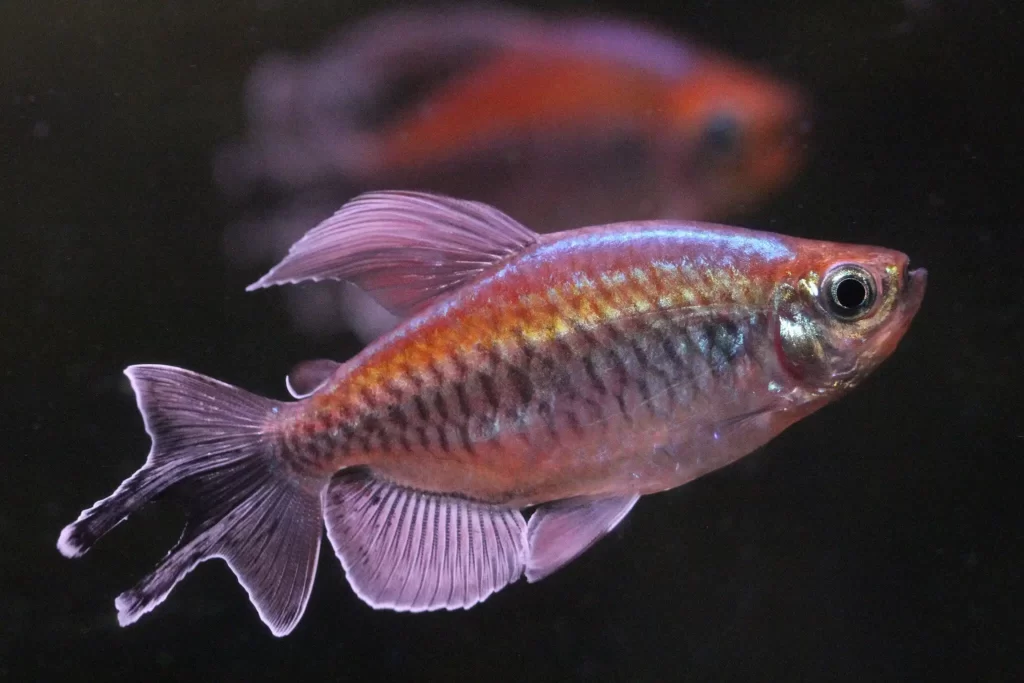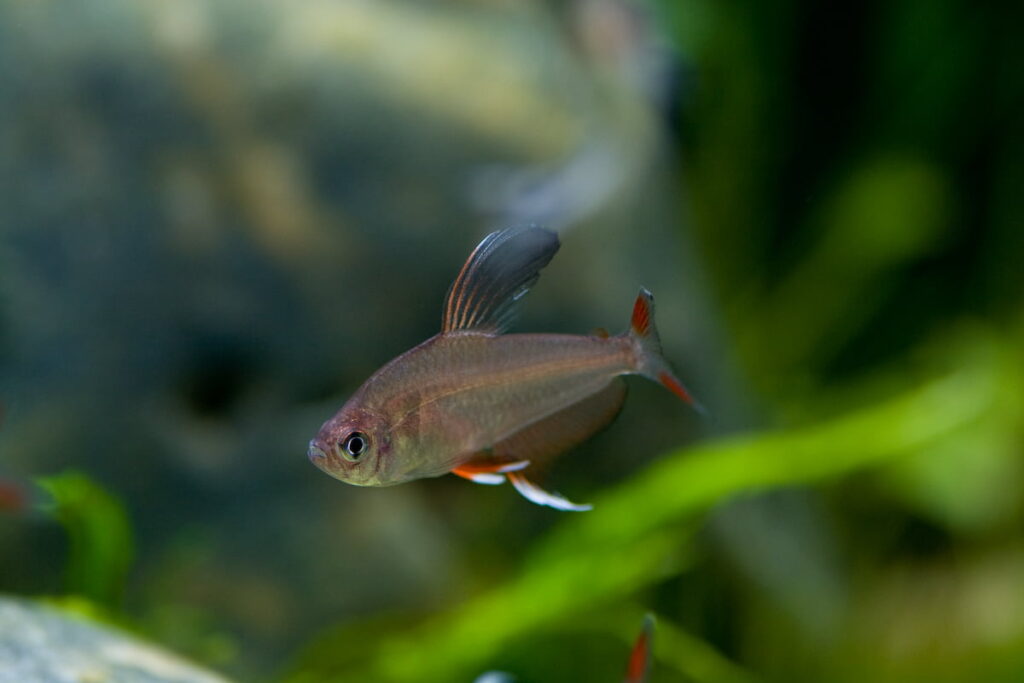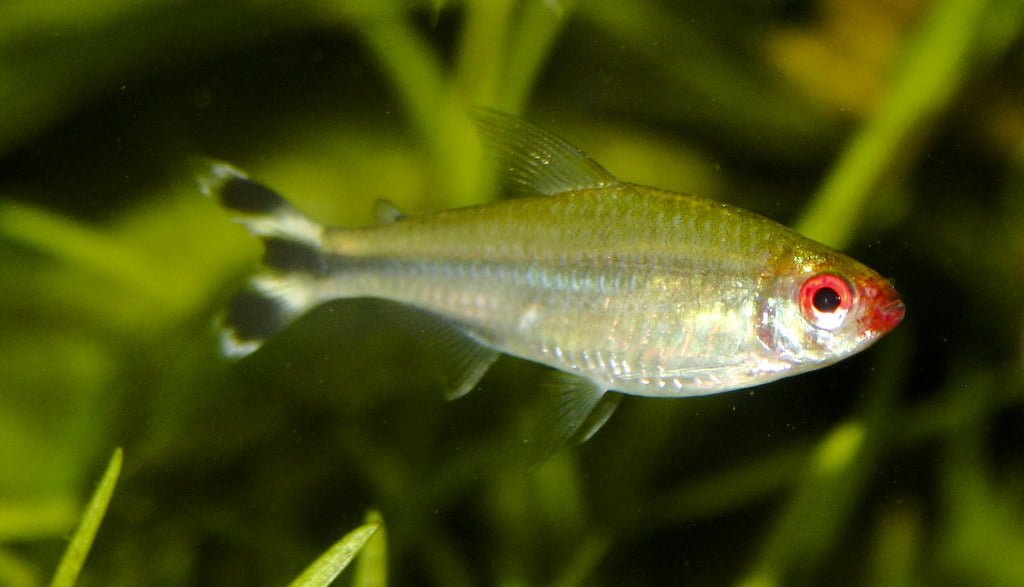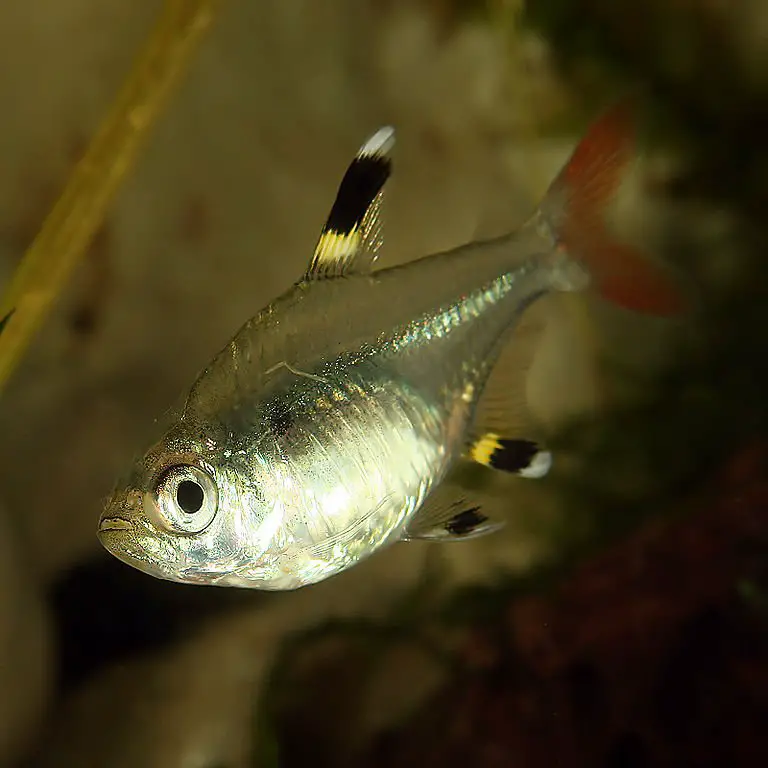Glowlight tetra (Hemigrammus erythrozonus) is one of the most common fish in the hobby. They are easily available in an aquarium shop, and almost everybody loves the color of their body. You experience their best color when they are kept in blackwater setup. Glowlight Tetra fish are peaceful, shoaling fish that are acceptable for a community tank; however, I would only do species tank, i.e., only glowlight tetra in a tank. They are hardy and can be recommended for beginners, but their skittish behavior can be a problem for many people.
I have always enjoyed them for their color. They bring such new aura in the tank and appreciate the beauty in the blackwater setup. Don’t get me wrong; there are various fish that look amazing in blackwater setup, but for me, glowlight tetra is the best. Their skittish behavior is something I have trouble as well, so I tend to be very gently (not surprise them) when I walk by or when I’m feeding them.
Introduction of Glowlight Tetra
Glowlight tetras (Hemigrammus erythrozonus) are shoaling fish. Shoaling fish are those fish that can live on their own, but when there is a predator or threat nearby, the group up to save themselves. They are hardy fish and can tolerate various range of water parameters. These species of tetra do best in slightly acidic and soft water. They are very skittish in nature. When you approach them suddenly, they tend to swim away fast and hit the walls of the tank. This causes various injuries. If not taken care of, these injuries can lead to various illnesses.
Classification
Kingdom: Animalia
Phylum: Chordata
Class: Actinopterygii
Order: Characiformes
Family: Characidae
Genus: Hemigrammus
Species: H. erythrozonus
Origin and Habitat
Glowlight tetras are South American fish. They are tropical fish that are found in the Essequibo River of Guyana, Mazaruni, and Potaro Rivers. The water conditions in these are naturally soft and acidic created by rotten leaves, an ideal condition for Glowlight Tetra to thrive.
The Glowlight Tetra fish was first introduced in the aquarium trade in 1933, where traders used to export from Asia and Germany. The fish was named Hemigrammus gracilis initially but was later changed to its current name Hemigrammus erythrozonus.
Description of Glowlight Tetra
Glowlight tetras are famous for their color. They have a translucent silvery color body where horizontal stripes run from head to tail. The stripes are red-orange color, which in blackwater looks like a glowing filament of bulb lights. Hence the name, glowlight tetra. It has gray tints to it.
They are often mistaken for Red Line or Glowlight Rasbora. Both of the fish have similar body markings; however, these two fish are completely different species.
They are small fish that can grow up to 1.5 inches (4cm).
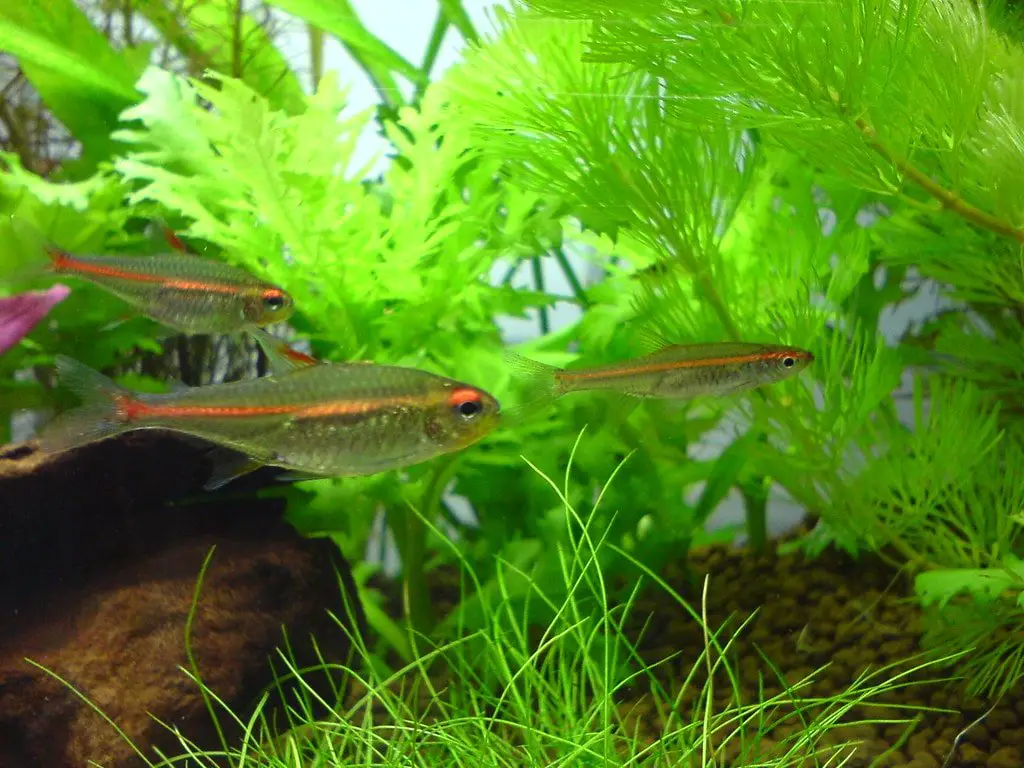
Numbers of Fish
Glowlight tetras are shoaling fish. They can do well on their own, but it is recommended to have at least 6-10 of them. Their skittish behavior stresses them out easily. They are so shy that they run away when you try to feed them. They find protection and relief in a shoal. If you are planning to keep these fish, provide them lots of hiding places as the last thing you want in your tank is stressed-out fish.
If you plan on getting lesser than 6, please don’t buy them.
Lifespan
They can live up to 5 years in captivity. To obtain this, you will need to provide them with nutritional food, maintain water parameters, and weekly water change.
Sex Differences
Females have larger and have a rounded body. Males are smaller than females and have a slender body.
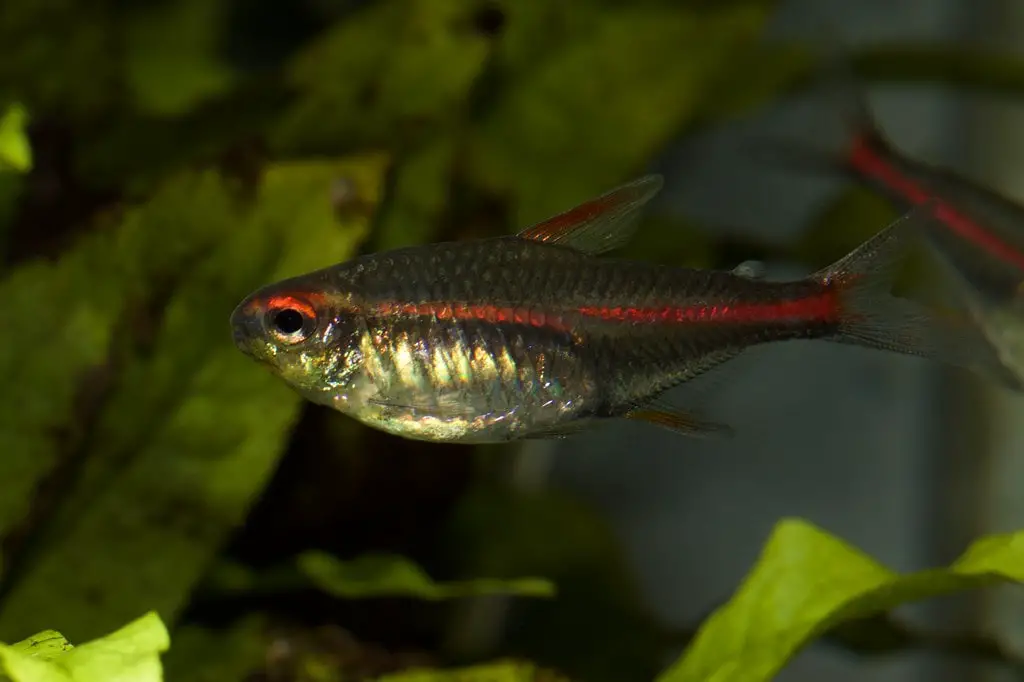
Fish Difficulty
Except for their skittish behavior, they are like any other fish. They wouldn’t be my recommendation fish for beginners, but if you have a few months/years of experience with any fish then, definitely go for. This is because, for glowlight fish, you need to know about fish stress and the importance of hiding place. For an experienced keeper, we can differentiate stressed out fish and unusual behavior of the fish. But for a beginner (those who have no past experience or just beginning), they might have a hard time telling if the fish is stressed or not.
Stress fish get sick when they are not taken care of. The last thing beginner keepers want to experience is their fish getting sick. This will stress the keeper as well and might lose love for the hobby.
Glowlight Tetra Diet
Glowlight tetras are very easy to feed. They eat anything you provide them. They mostly eat floating food. As they are omnivores; for best health and color, live and frozen food such as bloodworm, or live foods such as brine shrimp and Daphnia, along with dried flakes. They can be fed once or twice a day. Feed as much as they can eat within 1-2 minutes. Constant typical fish food can dull the color.
Proper high-quality food can improve their immunity to fight against diseases.
Aquarium Setup
Now that you have detail information about the fish, let’s look into how to set up the aquarium for Glowlight Tetra step by step. Here we will be discussing the tank size, their diet, maintaining temperature, and other factors that you will need to look into in detail when setting up a tank.
Tank Size
Glowlight Tetras are shoaling fish. They need a large area to swim around. Although they do swim separately when they are stressed, they group up and swim, and for that reason getting a long tank would be ideal. Length of at least 2 feet (15gal) would be great for a small number (6). If you get any more than this, get a bigger tank. They do amazing when they are in school. You will keep on appreciating their beauty.
I wouldn’t recommend them for nano tanks.
Water Type
Blackwater would be ideal for them. In nature, they live in tannin water, so you cannot go wrong with blackwater. Clearwater is also fine, but bright light isn’t their thing.
Also, in blackwater, you can experience their color; you will understand why they are called glowlight tetra. I would highly recommend them for the blackwater setup.
Filtration
Get a filter that isn’t too strong or too weak. Get a filter based on your tank size, so forceful flow won’t stress them out. If you get a slower flow rate, the filter will take a lot of time to cycle the water.
Decoration
Glowlight tetras aren’t demanding fish. Any decorations will work for them. You just have to keep in mind that you need to provide lots of hiding places. This fish gets stressed easily, and they will find places to hide. For hiding places, you can use plants, driftwoods, or put decorations that can hide fish for the keeper as well as other fish. It can be pot, rocks, or just simply toys with spaces.
For plants, you can use a java fern, anubias, and an amazon sword. Use floating plants as well, as this will give them a sense of protection from above the water.
Plastic plants would also work, but make sure they don’t have pointy edges. When they swim around the edges, they might cut themselves.
I recommend getting real plants as they give a more natural look to the aquarium, and it causes no hard to the fish. Plants also help in the nitrogen cycle, and they aren’t hard, so even if glowlight tetras were to run into them, they wouldn’t cause such serious harm.
Substrate
You want to get a substrate that will make the fish even more beautiful. Any substrates will work as long as it is dark-colored. Sand or pebble with the dark background will be the best for them.
Lighting
Glowlight tetras don’t like bright lights. This is also the reason why you don’t want to keep them in clear water. They thrive in dim lights where there are floating plants above them. I have heard from various people that you want lights that extend to only half of the tank, i.e. from the left side of the tank to center or right side of the tank to center. Yeah! That is how much they prefer dark.
Don’t run light all night or all day. This will cause you various problems with algae. Although algae do not harm fish, it will make your tank messy. Give 6-8 hours of light a day and turn off during night time. To be honest, lights in the aquarium are only needed when there are plants, for display or when your fish room is completely dark. Fish also need to get a sense of days and nights to regulate the biological clock (for this reason, we turn the lights off during night time). If your tank doesn’t have plants and your tank can get light from other sources during the day, then you don’t need to get a light.
Water Condition in the Tank
Glowlight tetras like any other tetras, they love slightly acidic water, warmer temperature and soft to medium hardness water. I keep them in tannin water as they love it, and their body lights up when proper lights are provided.
Temperature
They tolerate a wide range of temperatures, but they prefer warmer temperatures. They can survive from 72°F – 82°F (22°C – 28°C). I tend to keep them around 75°F (24°C).
Water pH and Hardness
They love soft acidic water. They can survive in the range of pH 5.5-7. I recommend them keeping at 6.5. They have already adapted to neutral pH, and few lesser than seven would be great for them.
They can survive from soft water to medium hardness water. They can survive from 6 – 15 dGH. Keep them in between this range.
Tank Mates
Glowlight Tetra is a peaceful fish. They are readily compatible with any other similar size, peaceful fish. They are shoaling fish; however, they don’t school with other fish, but oftentimes, they do school with their own strains. Glowlight tetras are most compatible with their own kind, and if you plan on keeping them with others, it will be because you want a variety of fish in your tank. If it is for a show, get neon tetras or cardinal tetras as both of them have iridescent stripes on their body, which looks fantastic in blackwater. However, do read about both of the fish before you keep them with glowlight tetras.
Other fish you can keep them with are rasbora, other tetras, guppies, barbs, Cory catfish, peaceful loaches, etc. Keep bottom dwellers as well, like mystery snails, shrimps, or Cory catfish.
If you already have other fish living with glowlight tetras, check other fish’s compatibility with bottom dwellers so that they don’t hunt.
It is better to keep glowlight tetras with slow-moving fish. Fast/active fish can stress them out. Danios and silvertip tetras will not be suitable for compatibility.
Semi-aggressive and aggressive will hunt them down.
Breeding Glowlight Tetra
Glowlight tetras are egg scatterers. They are breedable in captivity; however, they are challenging. They breed only when the right conditions are met. To breed, select females with a rounder body that can swim fastest and male with bright color.
Filter and Breeding Tank Condition
Get a separate tank for breeding. It doesn’t have to be huge. A 10-Gallon tank would work. You will need to fix water parameters, decoration (plants), and no lighting. All the elements will promote breeding.
Water parameters
The tank has to be slightly more acidic. Fix pH of 6-6.2.
Fix temperature of 78°F – 82°F (26°C – 28°C).
Hardness below 6dGH
Decoration
You want to have plants as much as possible. You don’t need to get high demanding plants. Guppy grass and java moss are most famous for breeding because they are easy to care, and fish love to breed near them. Plants also give hiding place for newly hatch fry.
Lighting
I have previously mentioned how lights affect glowlight tetras, and when it comes to breeding, they can breed without light as well; however, if you plan on keeping a light, the light should be dimmed as possible. They won’t breed in bright light.
Filter
Slow filer would be best. I recommend airstone as I don’t want the fry to be sucked into the filter. Or make use of sponge filters.
Breeding
Feed them 2-3 times day. Don’t put too much food. Just a bit. Continue this for a few days. Food is fed 2-3 times a day to give a female sense of that that there is lots of food for her babies as well. Also, to keep both male and female healthy. Having mosquito larvae in the tank also promotes breeding.
Once the female glowlight tetra has eggs, she will allow the male to swim near her. When they are ready, they will swim around plants. When they mate, the female turns upside down to release eggs, and the male will fertilize them. Females will lay from 100-150 eggs.
You will need a divider to separate eggs and parents while breeding. Make use of breeding mesh to keep out parents. And, as parents will eat their babies, separate parents after spawning.
Caring for the Eggs and Fry
Eggs will hatch after 24 hours. You don’t need to feed for the first 4-5 days as well will be attached to their yolk sac. After four days, feed them infusoria (ciliates, euglenoids, protozoa, unicellular algae, and small invertebrates) food for the first few weeks. As they get bigger, break down adult food and provide them a very tiny amount at a time.
Observe how they react to foods. Some might be picky, or they might find food too big to consume. If they don’t eat adult food, feed them infusoria then later again after a few days try adult food.
Just after three weeks, they will show the marking of glowlight fish. After four months, they will resemble their parents. In 9 months, females will be completely matured to give birth. However, I would recommend waiting for at least a year before you select for breeding.
Glowlight Tetra Diseases And Cure
Glowlight tetras are more prone to diseases because of their skittish behavior. Fish usually gets sick when they are stressed, and I think I have made it very clear how much this fish gets stressed.
But before you even put your fish into the tank, always get your fish quarantine tank for 1-2 weeks to see if they are already sick or is carry parasite. Provide a healthy diet and a weekly 50% water change. If they don’t get sick in this period of time, they are safe to put in your tank.
If they get sick while they are in quarantine, first identify the problem and start the treatment. In case your fish get sick when they are in the main tank, first identify the diseases than the source of the problem (it could be because of new fish that you didn’t quarantine, other fish are picking up on the sick fish, bad water parameters or wrong tankmates). Separate the fish to a small (hospital tank) tank so it will be easier to treat and monitor.
If the treatment is going to be on the main tank, remove active carbon.
Summary
Glowlight tetras are fantastic fish. If you get them, you get them for their colors. They are hard to breed, and you need to be very careful with them. They are shy fish and will hurt themselves when they try to run away from you. Give them plenty of hiding places to hide and always get them in large numbers.
Even though they are hardy, I wouldn’t recommend them for beginners. There is plenty of other fish for beginners. This fish needs special care in terms of being close to them.
Glowlight tetras are always to be appreciated for their beautiful color. Don’t mistake them for schooling fish, but they are community fish and will stay with slow swimmer fish.

